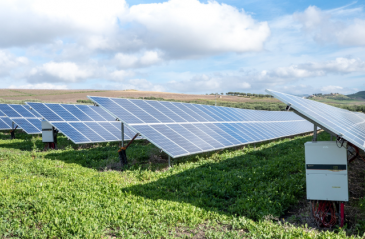
Oxford Citizens’ Assembly on Climate Change, Oxford, UK

In January 2019, Oxford City Council members unanimously declared a climate emergency and agreed to create a Citizens’ Climate Assembly to help consider new carbon targets and additional measures to reduce emissions.
The Assembly was tasked with responding to the following question: “The UK has legislation to reach ‘net zero’ by 2050. Should Oxford be more proactive and seek to achieve ‘net zero’ sooner than 2050?”, as well as discussing five key themes that the council had control and influence over: buildings, transport, renewable energy, biodiversity & offsetting, and waste reduction.1
42 residents from Oxford took part in two weekends of structured deliberation. Assembly members heard from experts, and were presented with three visions of possible futures for Oxford, developed by the City Council, and asked to vote on a series of specific pre-prepared questions.
The Council responded to the recommendations from the Citizens’ Assembly through their Sustainability Strategy and Action Plan, setting out clear targets and actions to cut emissions in buildings, transport, energy, waste and expand biodiversity across Oxford with the objective of achieving net-zero emissions across Oxford by 2030. A Climate Emergency Budget that commits new and additional funding of £19 million was also established to deliver on the Sustainability Strategy.2
Background and Context
The UK government passed a law committing the UK to achieve net-zero GHG emissions by 2050.3 This target has important socio-economic ramifications and will require significant and disruptive changes in public behaviour and consumption patterns. Following the UK net-zero commitment, a number of local authorities across the country declared a climate emergency, and initiated citizen deliberation processes to enable public input on acceptable local net-zero strategies.4
Oxford was the first City Council to initiate a Citizens’ Assembly on climate change in the UK. Citizens’ Assemblies give citizens the time and opportunity to learn about and discuss an issue in detail, before reaching conclusions and arriving at workable recommendations of what should be done.5 The approach is intended to help counteract divisiveness, shift power away from politicians and lobbyists, and increase the likelihood that different public perspectives are heard.
Oxford City Council have been keen advocates for participatory forms of decision making and the Assembly process was also broadly supported by local environmental and civic groups in the region.
The Initiative
In January 2019, Oxford City Council unanimously passed an amended motion declaring a climate emergency. As a result of this, Oxford City Council became one of the first local authorities in the UK to establish a Citizens’ Assembly on Climate Change.6
An independent cross-party advisory group was set up to provide governance and oversight of the creation, structure and operation of the Assembly. The advisory group included a councillor from each of the main political parties on the City Council, together with Oxford-based environment and democracy experts, and representatives from local industry.7 Ipsos MORI, a UK-based market research agency, was appointed to undertake the recruitment of participants and provide overall facilitation.8
The objective of the assembly was to assist the City Council in developing its mandate, strategy and budget on carbon abatement measures for 2020-2024, and interim targets to achieve net-zero. It was also hoped that the Assembly would give the Council some influence over other key carbon emitters such as universities and big businesses.
How was the climate change discourse presented and communicated?
Before the Assembly
In advance of the Oxford Citizens’ Assembly, participants received a 16-page briefing pack, explaining the Assembly process alongside a basic introduction to climate change, net zero, and implications for the Oxford context.9 The briefing pack also contained a myth-busting section on climate change to clarify common climate-related myths, clearly articulating that the existence of climate change was not up for debate during Assembly sessions. This could have influenced the recruited participants’ decision to participate (42 out of the 50 recruited participants joined the Assembly proceedings over the two weekends. The absenteeism of the 8 remaining participants was not investigated).10 The information presented through the briefing-pack was fairly simple, to-the-point, and easy to understand, although it was acknowledged that more could have been done to make the content engaging and tailored to participant understanding and interest.
During the Assembly
The Assembly participants engaged with the broader question: “The UK has legislation to reach ‘net zero’ by 2050. Should Oxford be more proactive and seek to achieve ‘net zero’ sooner than 2050?”, from three thematic lenses (using less energy; making more clean energy; improving the quality of the environment) further divided into five sectors (buildings; transport; renewable energy; biodiversity & offsetting; waste reduction) relevant to key GHG emission sources in Oxford.11,12 Participants agreed that the narrowed framing allowed them to build a more focussed understanding of the issue and generate meaningful recommendations.
The information on climate change was presented to the public through a mixture of expert speakers (including academics, environmental groups and Council representatives), with efforts made by the oversight panel to ensure a balanced picture of the challenge and response options in different sectors were presented to participants. All expert speakers emphasised the urgency, seriousness, and also the fixability of the challenge, thereby shaping the tone and content of the deliberation that followed to be positive and ambitious.13
The sector-specific expert sessions were fairly technical, presented by technical stakeholders and practitioners, which is likely due to the Assembly process being set up with the objective of gathering recommendations to inform Council policy. Interestingly, however, the technical conversation seemed suited to the Assembly members as Q&A sessions and deliberation processes showcased keen engagement and interest on what was viable, feasible and cost-efficient. Feedback forms also showed high levels of satisfaction with the facilitation and speaker presentations from the Assembly.14 On recruitment of the Assembly members, it is important to note that, like many local authorities, Oxford has an existing panel of residents used for consultations. Most members of the Assembly were recruited through the panel, with gaps in representation filled through a secondary stage of street recruitment. The assembly participants were stratified across gender, age, ethnicity, disability, and area of residence within Oxford, to serve as a representative microcosm of the population of Oxford. Other variables were monitored but not used as selection criteria such as social grade, educational attainment, working status, length of Oxford residency, and environmental and political attitudes.15
After the Assembly
At the end of the last session each participant was given a well-researched take home pack with additional resources to guide them on taking personal or community action, or simply starting conversations about climate change with others.16
On communicating with the wider public, Oxford Council published the timetables, videos of the expert speaker presentations and deliberation synthesis sessions, on their local authority websites. Also included were all materials supplied to Assembly participants, and the composition of the Advisory Committee.17 This kind of practice can show participants and the wider public how the exercise feeds into the broader democratic process, and build support for, and discussion about, the wider role of citizens’ assemblies in democratic politics.
What was the extent and nature of citizen collaboration in the Assembly?
Participants of the Oxford Climate Assembly were provided with a controlled collaboration space in which to develop recommendations, based on a rigorous process of considered and informed deliberation. The deliberations were bolstered by the Council’s repeated emphasis on the importance of the Assembly process, with clear explanations of how the recommendations will be responded to.
In the first weekend of the Assembly, each presentation slot consisted of between one and four main presentations (of up to 10 minutes) plus additional shorter presentations (usually three-minutes), regular icebreakers, individual reflection, frequent opportunities to work in small groups and occasionally as one large group (plenary) helped to vary the discussions. As a take-home task for participants in the three weeks before the next Assembly session, they were asked to talk to family, friends, colleagues; discuss how important different issues were to them; and think through a prioritisation. All videos of the sessions were also made available online, for reference and to aid external discussion.18
The second weekend was devoted to deliberation, a visioning activity and prioritisation across different courses of action. Courses of action spanned areas that the Council had direct control over, where it was able to work in partnership with other statutory bodies and where it could influence others. The weekend culminated in a series of voting exercises. Assembly members were presented with three visions of possible scenarios, ranging from least to most ambitious. Members were asked to vote which scenario they would like to live in. Given that the objective of the Oxford Assembly process was to inform the City Council’s Strategy and Budget, the design of the sessions along a tight, specific set of scenarios and policy options did well to streamline the conversation to deliver clear messages on citizen recommendations for action.19
What was the level of action addressed by the public engagement?
The Assembly sessions and the participant discussions considered the responsibilities of the City Council, businesses, institutions, and individuals. In this sense the process was underpinned by a multi-faceted understanding of the behaviour change needed, and the recommended policy options were targeted at addressing action at the individual, community and systems level.
The primary objective of the public engagement through the Assembly process was to produce a set of recommendations that informed Council policy and budgets. The emphasis through the facilitation of the sessions was on guidance and steering of the participants; the Assembly itself was not designed to establish specific policy interventions (for example, no technical engagement with trade-offs and budgeting was required), but rather to indicate citizen preferences on the direction interventions should take, and the intensity of action deemed publicly acceptable. The Assembly process also provided the Council some influence over other key carbon emitters such as universities and big businesses.
The Public Impact
The Assembly recommended that Oxford City Council take on a leadership role in the climate crisis and aim to achieve net-zero emissions sooner than 2050. In addition, sector-specific recommendations were made on how the Council could cut emissions in buildings, transport, energy, waste and expand biodiversity across Oxford. The Council was also asked to build a shared strategy to reach net-zero emissions that showcased the roles played by local and national government, businesses, and individuals. In response, the Council has taken the following actions:
Developed a Sustainability Strategy and Action Plan on how the Council and City will achieve net-zero emissions by 2030, by raising the energy efficiency of new homes and community buildings, cutting transport emissions, boosting renewable energy installation, expanding biodiversity across the city, and increasing public engagement with recycling, in keeping with the Assembly’s recommendations.
Established a Climate Emergency Budget that commits new and additional funding of £18 million of capital investment to deliver on the Sustainability Strategy, plus £1 million operational funds. This amount was set aside in addition to the £84 million of ongoing investment to tackle the climate emergency in Oxford.
Instituted an organisational change within the Council, through the set up of a cross-departmental panel dedicated to better coordinating the response to climate change.
Set up a Zero Carbon Oxford Partnership to involve major emitters in the city in developing a shared vision and plan towards a Zero Carbon Oxford. A Zero Carbon Oxford summit is also being planned.20
Further Considerations and Lessons from this Case
From CPI’s extensive work on public engagement, we have found three important drivers to public impact that are relevant to discuss when designing public engagement processes around climate change: Enabling adaptability and learning; Designing for Inclusion; and Embracing Complexity. We discuss its relevance to the case study below:
Enabling Adaptability and Learning
A Citizen Assembly, when designed and commissioned to foster collective learning, dialogue, and deliberation, can build trust between citizens and the government, produce better and fairer policies, and act as a catalyst for better partnerships. However, most Citizen Assemblies require a significant financial and time commitment on part of the commissioning body, alongside a commitment to meaningful follow-up on the recommendations. In the case of the Oxford Climate Assembly, the Oxford City Council clearly and regularly articulated the purpose of the process and how it would feed into policy, budget and strategy. These steps enabled the Council to foster legitimacy and trust through the design and implementation of the Assembly. As a consequence of the clearly articulated objective, however, the Assembly sessions were tightly framed, which has its advantages and disadvantages. The advantage is that the final recommendations delivered clear messages to the Council on the action they should take, in typically contentious areas of policy, enabling diligent action. However, it is important to note that such a tightly scripted framing of the policy context presented by technical experts, and the choice of pre-constructed scenarios to choose from, has the propensity to set the language, content and tone for what is and isn’t discussed. In this case, it is likely that this potentially held participants back from discussing lived experience and personal priorities.
Similarly, the framing of the overarching question, or more subtly the choice of external speakers, may also dictate deliberation processes, options considered, and the recommendations themselves. It is critical for the Assembly process to allow for sufficient flexibility and iteration in the design, to flex and accommodate new ideas and feedback from participants. When this isn’t the case, it could restrict sustained public engagement on the issues discussed, as the process doesn’t adequately recognise and value different ways of knowing, being, and learning. Partly, this is a result of the role the Assembly was perceived to play, which is to produce recommendations to inform policy making, rather than as a tool to start a wider public dialogue. However, by upholding this narrative, the Council likely misses the opportunity to have a broader discussion on the role citizen assemblies can play in instituting sustained two-way learning, on complex value-laden issues such as climate change. A way forward might involve commissioning and designing an Assembly as one part of a wider public engagement and learning process, as a way to bolster government legitimacy and design truly inclusive policy action and public impact.
Designing for Inclusion
The approach to Inclusion in recruitment for the Oxford Climate Assembly involved using stratified random sampling to identify a representative sample of the population from the Council’s existing citizen panel. This was supported with a second round of street recruitment to fill in the gaps in representation. It is, however, important to note that random stratified sampling is only as inclusive as the database it uses to recruit participants (for example, if it uses the electoral register, a database of landlines, or a database of addresses it excludes people who are not on this database). Further, the diversity and representativeness of the Assembly was heavily contingent upon the selection criteria chosen (for example, the criteria of socioeconomic group, employment status, educational attainment or political viewpoint could have been included as selection criteria but were not in this case). Unless criteria such as educational attainment is used to diversify the sample, it is likely that the process sees an overrepresentation of educated, middle-class participants, skewing the areas of interest and discussion, and consequently the final recommendations. We also know relatively little about those who turn down invitations and their reasons for doing so. It is therefore unclear whether the process systematically excludes particular groups, and what difference their inclusion may have on the deliberations.
Importantly, deliberative processes bring a diverse group of people together who start to understand and appreciate the realities of each other’s lives, and a Citizen Assembly provides a critical opportunity to move the discussion away from individual preferences to conversations on the greater collective good. In that sense, considerations of inclusion within the Oxford Assembly design could also have been more explicit, such as asking participants to share personal experiences, values, and thoughts on climate policies through the process, in acknowledgement that their knowledge and experience is valued as much as that of other technical experts. Further opportunities to mix and build relationships informally at the outset to create the right conditions for people to feel included could have aided this process and serves as an important area for further discussion and research.
Embracing Complexity
Climate change is a complex and wicked challenge to tackle within a Citizen Assembly process. Climate change is difficult to clearly define, has multiple interdependencies, and is constantly evolving. In addition, as it has no clear solution, policy actions can have unintended consequences, and no one actor is responsible for all aspects of the challenge. Structuring deliberation around the subject is therefore inherently challenging.
The Oxford Climate Assembly did well to focus the challenge on place-based issues relevant to Oxford City and the participants in the room. The sessions also clearly articulated that the Council can only go so far in reducing the climate impacts within the region without multi-level multi-sectoral partnerships and collaboration with local businesses, institutions, and citizens. This enabled the participants to understand and engage with the interlinked nature of the climate challenge, and the need for co-design and collaboration in policy identification and implementation.
The Assembly also provided adequate background information and take-home readings, and expert advice to enable the public to engage in informed deliberation and reach meaningful decisions about the future course of action. However, with an issue as complex as climate change it may always be possible to debate whether two weekends of dedicated deliberation are sufficient, and whether more time and more resources could have supported a richer understanding of the process. The Draft Citizen Assembly Standards put together by Involve in collaboration with a number of deliberative democracy practitioners suggests that the climate emergency warrants investment in a longer process; one in which people have time to come to an understanding of the challenging issues, develop relationships, share experiences, challenge each other, consider new information and move from an individual perspective to consider what may constitute a vision for the greater public good.21 It is therefore important to always question how an Assembly process can aspire to meet those objectives more effectively and comprehensively, in the longer-term.
Bibliography
[1][2][6] City Council responds to Oxford Citizens’ Assembly on Climate Change and outlines £19m climate emergency budget, 16 December 2019, Oxford City Council, https://www.oxford.gov.uk/news/article/1275/city_council_responds_to_oxford_citizens_assembly_on_climate_change_and_outlines_19m_climate_emergency_budget, Accessed 11 February 2021
[3] UK becomes first major economy to pass net zero emissions law, 27 June 2019, Department for Business, Energy & Industrial Strategy and The Rt Hon Chris Skidmore MP, https://www.gov.uk/government/news/uk-becomes-first-major-economy-to-pass-net-zero-emissions-law, Accessed 12 February 2021
[4] Climate Change, Local Government Association, https://www.local.gov.uk/topics/environment-and-waste/climate-change, Accessed 13 February 2021
[5][8] Oxford Citizens Assembly on Climate Change, 2021, Oxford City Council, https://www.oxford.gov.uk/info/20011/environment/1343/oxford_citizens_assembly_on_climate_change#:~:text=In%20January%202019%2C%20Oxford%20City,additional%20measures%20to%20reduce%20emissions, Accessed 10 February 2021
[7] Oxford Citizens Assembly on Climate Change - Advisory Group Members, 2021, Oxford City Council, https://www.oxford.gov.uk/info/20011/environment/1343/oxford_citizens_assembly_on_climate_change/2, Accessed 10 February 2021
[9] Participants Briefing Pack Oxford Citizens Assembly on Climate Change, 2021, Oxford City Council, https://www.oxford.gov.uk/downloads/file/6645/participants_briefing_pack_oxford_citizens_assembly_on_climate_change, Accessed 10 February 2021
[10] Oxford Citizens Assembly on Climate Change backs ambitious approach to achieving zero carbon, 25 October 2019, Oxford City Council, https://www.oxford.gov.uk/news/article/1224/oxford_citizens_assembly_on_climate_change_backs_ambitious_approach_to_achieving_zero_carbon, Accessed 10 February 2021
[11] Oxford Citizens Assembly on Climate Change - Key Information, 2021, Oxford City Council, https://www.oxford.gov.uk/info/20011/environment/1343/oxford_citizens_assembly_on_climate_change/3, Accessed 10 February 2021
[12] Schedule for weekend one of citizens assembly, 2021, Oxford City Council, https://www.oxford.gov.uk/downloads/file/6661/schedule_for_weekend_one_of_citizens_assembly, Accessed 10 February 2021
[13][14][15][18][19] Oxford Citizens Assembly on Climate Change, https://www.ipsos.com/sites/default/files/ct/publication/documents/2019-11/oxford-citizens-assembly-climate-change-report.pdf
[16] Take home pack for Citizens Assembly, 2021, Oxford City Council, 2019, Ipsos MORI, 2019, https://www.oxford.gov.uk/downloads/file/6787/take_home_pack_for_citizens_assembly, Accessed 12 February 2021
[17] Oxford Citizens Assembly on Climate Change - Presentations and materials, 2021, Oxford City Council, https://www.oxford.gov.uk/info/20011/environment/1343/oxford_citizens_assembly_on_climate_change/5, Accessed February 10 2021
[20] City Council responds to Oxford Citizens’ Assembly on Climate Change and outlines £19m climate emergency budget, 16 December 2019, https://www.oxford.gov.uk/news/article/1275/city_council_responds_to_oxford_citizens_assembly_on_climate_change_and_outlines_19m_climate_emergency_budget, Accessed February 11 2021
[21] Standards for Citizens’ Assemblies, Involve, https://www.involve.org.uk/resources/knowledge-base/how-do-i-setup-citizens-assembly/standards-citizens-assemblies, Accessed 18 February 2021

Engaging the Public on Climate Change
Our Case Study Compendium provides practitioners with a framework to unpack different approaches, outlining how public engagement can better embrace the complexity of climate issues.
You may also be interested in...


Food: Too good to waste (FTGTW) network, U.S.


Forest Investment Program: High Forest Zone, Ghana

Waste Management Cooperative: Pune, India

Community Energy Cooperative: Schönau, Germany
